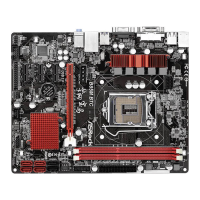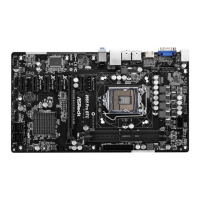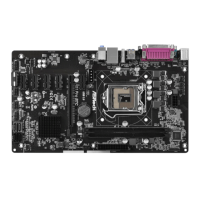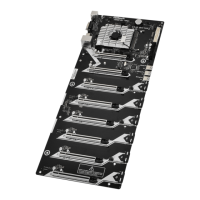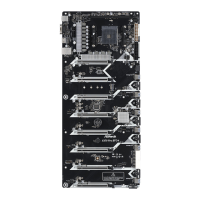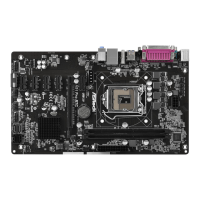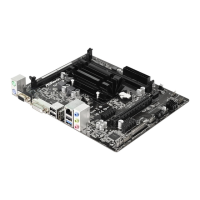Do you have a question about the ASROCK Q270 Pro BTC+ and is the answer not in the manual?
Lists all items included in the motherboard package.
Details the technical specifications of the motherboard, including CPU, Chipset, Memory, and Expansion Slots.
Visual guide to the physical layout of the motherboard components and connectors.
Describes the rear panel input/output ports and their functions.
Step-by-step instructions for correctly installing the CPU into the motherboard socket.
Guide on how to mount the CPU fan and heatsink assembly onto the motherboard.
Instructions for properly inserting DDR4 DIMM modules into the motherboard slots.
Details on the available PCI Express slots and their intended uses for expansion cards.
Explains the function and setup of various jumpers on the motherboard, like the Clear CMOS jumper.
Identifies and describes the function of onboard headers and connectors for chassis components.
Explains the functionality of the motherboard's onboard power and reset buttons.
Instructions for connecting PCIe power connectors, especially for multiple graphics cards.
Step-by-step guide for installing an M.2 SSD module onto the motherboard.
Details unique features of the motherboard.
Guide on how to install necessary drivers from the support CD for optimal performance.
Information on using ASRock's utility for updating BIOS, drivers, and installing applications.
Explains how to access and navigate the UEFI Setup Utility for system configuration.
Displays the system overview and basic information upon entering the UEFI utility.
Section for configuring overclocking features and performance settings.
Allows detailed configuration of various system components like CPU, Chipset, and Storage.
Provides access to utility tools for system maintenance and updates.
Allows monitoring of system hardware status, including temperatures, fan speeds, and voltages.
For setting and managing system passwords and security features.
Configures boot settings, device priority, and boot-related options.
Options for saving changes, discarding them, or loading default settings before exiting the utility.
Lists all items included in the motherboard package.
Details the technical specifications of the motherboard, including CPU, Chipset, Memory, and Expansion Slots.
Visual guide to the physical layout of the motherboard components and connectors.
Describes the rear panel input/output ports and their functions.
Step-by-step instructions for correctly installing the CPU into the motherboard socket.
Guide on how to mount the CPU fan and heatsink assembly onto the motherboard.
Instructions for properly inserting DDR4 DIMM modules into the motherboard slots.
Details on the available PCI Express slots and their intended uses for expansion cards.
Explains the function and setup of various jumpers on the motherboard, like the Clear CMOS jumper.
Identifies and describes the function of onboard headers and connectors for chassis components.
Explains the functionality of the motherboard's onboard power and reset buttons.
Instructions for connecting PCIe power connectors, especially for multiple graphics cards.
Step-by-step guide for installing an M.2 SSD module onto the motherboard.
Details unique features of the motherboard.
Guide on how to install necessary drivers from the support CD for optimal performance.
Information on using ASRock's utility for updating BIOS, drivers, and installing applications.
Explains how to access and navigate the UEFI Setup Utility for system configuration.
Displays the system overview and basic information upon entering the UEFI utility.
Section for configuring overclocking features and performance settings.
Allows detailed configuration of various system components like CPU, Chipset, and Storage.
Provides access to utility tools for system maintenance and updates.
Allows monitoring of system hardware status, including temperatures, fan speeds, and voltages.
For setting and managing system passwords and security features.
Configures boot settings, device priority, and boot-related options.
Options for saving changes, discarding them, or loading default settings before exiting the utility.
| Processor socket | LGA 1151 (Socket H4) |
|---|---|
| Processor manufacturer | Intel |
| Compatible processor series | Intel Celeron, Intel Core i3, Intel Core i5, Intel Pentium |
| Non-ECC | Yes |
| Memory channels | Dual-channel |
| Memory slots type | DIMM |
| Number of memory slots | 2 |
| Supported memory types | DDR4-SDRAM |
| Maximum internal memory | 32 GB |
| Supported memory clock speeds | 2133, 2400 MHz |
| RAID levels | 0, 1, 5, 10 |
| Supported storage drive types | HDD & SSD |
| Number of storage drives supported | 5 |
| Supported storage drive interfaces | M.2, SATA III |
| Parallel processing technology support | Not supported |
| USB 2.0 connectors | 1 |
| Number of SATA III connectors | 4 |
| USB 3.2 Gen 2 (3.1 Gen 2) connectors | 0 |
| USB 2.0 ports quantity | USB 2.0 ports have a data transmission speed of 480 Mbps, and are backwards compatible with USB 1.1 ports. You can connect all kinds of peripheral devices to them. |
| Wi-Fi | No |
| LAN controller | Intel® I219-V |
| Ethernet interface type | Gigabit Ethernet |
| Audio chip | Realtek ALC897 |
| Component for | PC |
| Motherboard chipset | Intel® Q270 |
| Audio output channels | 7.1 channels |
| Motherboard form factor | ATX |
| Windows operating systems supported | Windows 10 x64, Windows 7, Windows 8.1 x64 |
| PCI Express x1 (Gen 3.x) slots | 12 |
| BIOS type | UEFI AMI |
| ACPI version | 6.0 |
| BIOS memory size | 128 Mbit |
| System Management BIOS (SMBIOS) version | 2.7 |
| Cables included | SATA |
| Harmonized System (HS) code | 84733020 |
| Weight | 500 g |
| Depth | 208 mm |
|---|---|
| Width | 305 mm |
| Height | 55 mm |
